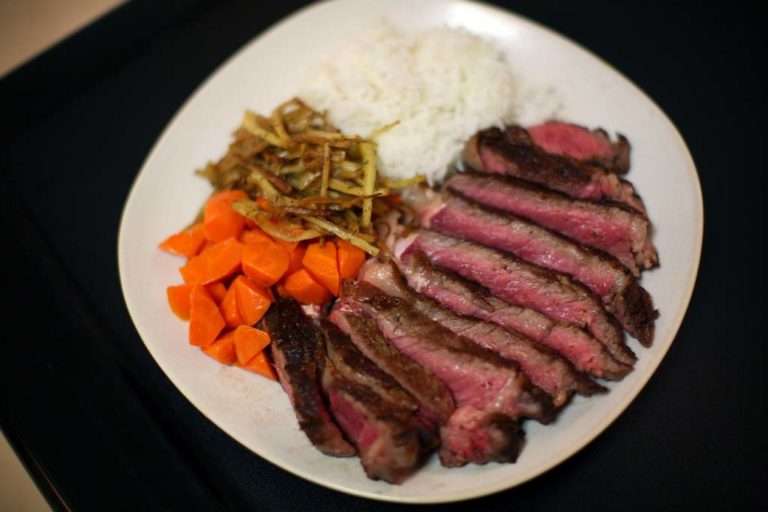
Chef's notes:
Pan frying is one of those things that is hard to do right in a regular kitchen. Most people get nervous when their kitchen starts smoking, but smoke is a natural part of cooking. Unfortunately , when people see smoke, they immediately turn down the heat and never turn it that high again, which is too bad because high heat cooking produces great food.
In high heat cooking, we get caramelization of the food through a process known as the Maillard reaction. Caramel, as you may know, is impossible to get without high heat (think candy). This is why following my directions below is so crucial, as it will make or break your meal. If your kitchen is equipped with a vent, turn it on. If not, open the windows and turn on a fan because it’s gonna get smoky.
Ingredients
- 2 thick-cut beef ribeyes
- Sea salt
- Black pepper
- Safflower oil
- Butter
Beef Ribeye Steak Seasoned with Sea Salt and Pepper then Pan-Fried in Butter
- Take your steak out of the refrigerator an hour before you want to start cooking it. It is always best to cook meat from or near room temperature. This will help the meat cook consistently across the interior by reducing the amount of time that it takes to cook the meat. If your meat needs to be trimmed or cut into smaller pieces, do that now. I chose to leave my steaks the way they are. ‘Cause I’m fat.
- It is best to not go too crazy choosing the seasoning for your ribeye. This cut of beef is very tender, and it would best to keep the seasoning limited to the following: good sea salt, fresh cracked black pepper, and a little high-temperature oil like safflower. Rub the steaks with salt and pepper first, followed by a thin layer of the safflower oil.
- Heat up a heavy-bottomed frying pan on medium heat. Melt a tablespoon of butter in the pan and wait until the butter foam subsides before laying your steak down in the very center of the pan. Don’t cover the pan or move the steak for at least 4 minutes. When you begin to see the sides of the steak getting brown, pick up the steak and look at the bottom. If it is dark brown, flip it over.
- The second side will take another five minutes to brown. The steak to the right was 1½ inches thick and needed 4 minutes more per side before it was medium rare. So, depending on how thick your steaks are, you may need to cook them longer. Use a digital thermometer to test the internal temperature of the steaks. For rare meat, 120–125 degrees F, medium is 140–150 degrees, and well done is around 160–170 degrees.
Tips & Tricks
- The fat on a steak will always taste better after it has been rendered by high heat. Just cooking a steak to rare doesn’t mean it is going to be delicious. It needs to be hot in order to help separate some of the connective tissue (sinewy stuff) from the meat. Otherwise the steak will be chewy. Also, high heat ensures that the fat gets caramelized.
- After browning each side of the steak, it is fairly common to finish it in the oven. The reason being that cooking a thick steak all the way through on top of the stove could burn the steak if left uncovered. And if you cover it, then you end up with steamed meat instead of fried, which is a nasty way to cook a steak. Just put the pan directly from the stove top into a preheated 450 degree F oven, and roast until it reaches your desired doneness/temperature.
